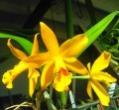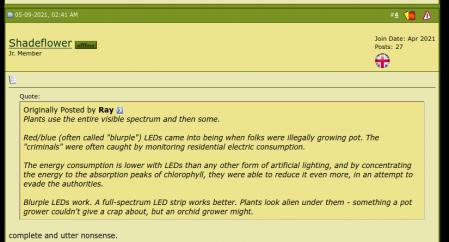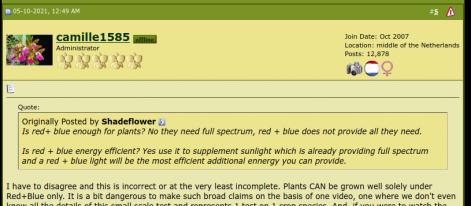


Donate Now
and become
Forum Supporter.

Many perks!
<...more...>


|

05-08-2021, 01:52 AM
|
|
Senior Member
|
|
Join Date: Oct 2016
Zone: 7b
Location: Ankara, Türkiye
Posts: 248
|
|
 Full spectrum T5 vs. Red/blue LED
Full spectrum T5 vs. Red/blue LED
I glanced through but didn't see a comparison on these two. Perhaps i missed it?
Either way, today someone dropped off for me a grow light that comes with red/blue LED strips. Up to this point, I've been growing under sunblaster full spectrum t5 bulbs. I was curious if anyone can compare the two. What are the advantages of either? Is it better to use one or the other? Do certain orchids thrive better under one kind of lighting or another? I'm basically trying to figure out if I want to use this free light stand and where
|

05-08-2021, 06:47 AM
|
 |
Senior Member
|
|
Join Date: May 2005
Location: Oak Island NC
Posts: 14,857
|
|
Plants use the entire visible spectrum and then some.
Red/blue (often called "blurple") LEDs came into being when folks were illegally growing pot. The "criminals" were often caught by monitoring residential electric consumption.
The energy consumption is lower with LEDs than any other form of artificial lighting, and by concentrating the energy to the absorption peaks of chlorophyll, they were able to reduce it even more, in an attempt to evade the authorities.
Blurple LEDs work. A full-spectrum LED strip works better. Plants look alien under them - something a pot grower couldn't give a crap about, but an orchid grower might.
|
|
Post Thanks / Like - 2 Likes
|
|
|
|
|

05-08-2021, 09:16 AM
|
|
Senior Member
|
|
Join Date: Aug 2020
Zone: 7b
Location: Harrisburg, PA
Posts: 189
|
|
I recommend against blurple because it's harder for the human eye to detect problems early.
|
|
Post Thanks / Like - 1 Likes
|
|
|
|
|

05-08-2021, 10:06 AM
|
|
Senior Member
|
|
Join Date: Oct 2016
Zone: 7b
Location: Ankara, Türkiye
Posts: 248
|
|
Quote:
Originally Posted by Ray

Blurple LEDs work. A full-spectrum LED strip works better. Plants look alien under them - something a pot grower couldn't give a crap about, but an orchid grower might.
|
When you say they look alien, does that mean their normal growth patterns look different than the growth under blurple? Thank you for the explanation by the way. |

05-09-2021, 05:41 AM
|
|
Banned
|
|
Join Date: Apr 2021
Posts: 1,247
|
|

Quote:
Originally Posted by Ray

Plants use the entire visible spectrum and then some.
Red/blue (often called "blurple") LEDs came into being when folks were illegally growing pot. The "criminals" were often caught by monitoring residential electric consumption.
The energy consumption is lower with LEDs than any other form of artificial lighting, and by concentrating the energy to the absorption peaks of chlorophyll, they were able to reduce it even more, in an attempt to evade the authorities.
Blurple LEDs work. A full-spectrum LED strip works better. Plants look alien under them - something a pot grower couldn't give a crap about, but an orchid grower might.
|
complete and utter nonsense.
Red and blue led's were primarily produced by the marine fish industry and the fact that the red and blue diodes were the cheapest LED's to produce out of all colors. They knew lights needed more than just blue and red but they claimed that is all plants needed and their lights were engineered to be the most efficient.
Did pot growers have anything to do with LED's getting developed? Certainly not lol.
Is red+ blue enough for plants? No they need full spectrum, red + blue does not provide all they need.
Is red + blue energy efficient? Yes use it to supplement sunlight which is already providing full spectrum and a red + blue light will be the most efficient additional ennergy you can provide.
red + blue comparrison to Full sprectrum:
Last edited by Shadeflower; 05-09-2021 at 05:52 AM..
|

05-09-2021, 07:33 AM
|
 |
Senior Member
|
|
Join Date: May 2005
Location: Oak Island NC
Posts: 14,857
|
|

Quote:
Originally Posted by 3rdMaestro

When you say they look alien, does that mean their normal growth patterns look different than the growth under blurple? Thank you for the explanation by the way.
|
No, it means the human eye, having no green reflected to it, perceives the vegetation as almost being black.
Quote:
Originally Posted by Shadeflower

complete and utter nonsense.
|
From what I’ve read, illicit pot growers were the first to adopt their use in horticulture (not developed them) which is far more pertinent than raising fish. Apparently the history you read was different. No need to be an ass.
I can also say with certainty that different plants behave differently when exposed to different spectra. Back when I was designing LEDs for orchids, I participated in a group that was experimenting with “tweaking” spectra for different purposes. The group primarily worked with vegetables, as they grow quickly and it’s easy to discern positive and negative outcomes, and leaf vegetables and “fruit” vegetables reacted a great deal differently, so how you can think a lettuce video pertains to orchid growing is beyond me.
Last edited by Ray; 05-09-2021 at 07:42 AM..
|

05-10-2021, 03:49 AM
|
 |
Administrator
|
|
Join Date: Oct 2007
Location: middle of the Netherlands
Posts: 13,695
|
|

Quote:
Originally Posted by Shadeflower

Is red+ blue enough for plants? No they need full spectrum, red + blue does not provide all they need.
Is red + blue energy efficient? Yes use it to supplement sunlight which is already providing full spectrum and a red + blue light will be the most efficient additional ennergy you can provide.
|
I have to disagree and this is incorrect or at the very least incomplete. Plants CAN be grown well solely under Red+Blue only. It is a bit dangerous to make such broad claims on the basis of one video, one where we don't even know all the details of this small scale test and represents 1 test on 1 crop species. And, if you were to watch the other video in the same channel which repeats the trial with soybean, you would see that he comes to the opposite conclusions. 
I would also like to make a few points to correct this statement.
1) Nearly everything can be grown under a Blue+Red spectrum, oftentimes very well. These include leafy greens, herbs, tomatoes, cucumbers, peppers, orchids and many types of field grown crops.
2) The type of light isn't the only thing to consider. The ratio of blue to red will also have some very strong effects, also depending on the crops. For instance in your lettuce video, if the fixture he used has a relatively high proportion of blue then the plants will have more compact growth and lower fresh weight. If he had measured the plant dry weight, he may have found that the Blue+Red grown plants had produced more dry biomass. Generally in lettuce, the higher the proportion of red, the more fresh weight you get, but the trade off is often lower dry weight which translates to shorter shelf life. I can also tell you that soybean (keeping to the example videos) reacts more favorably to extra blue light.
3) While plants do use other wavelengths of the spectrum their impact on yield and development can be minor. The only other wavelengths that I would agree are often important would be those in the far red range, because of the very strong effects these have on plant physiology.
__________________
Camille
Completely orchid obsessed and loving every minute of it....
My Orchid Photos
Last edited by camille1585; 05-10-2021 at 05:44 AM..
|
|
Post Thanks / Like - 1 Likes
|
|
|
|
|

05-15-2021, 04:48 PM
|
|
Banned
|
|
Join Date: Sep 2020
Posts: 441
|
|

camille, I have to disagree and I think I can safely make such broad claims - if it helps people who have never grown under LED's before.
You mention the second video. Even in the second video you will notice that the plants you claim turned out superior did not grow right and the taste well look at his face when he eats it.
You seem to want to defend blue+red lights, that makes me believe you want to justify your use of them and can't justify getting a better light. That is fine, but the evidence is indesputable. If you wish to dispute it you are achieving nothing but to confuse people.
I know you think you are doing it because you think I or the person making that video doesn't know better.
The only way to know better is to try. I have, he has, you want to justify that red+blue works just as well.
If you finish the second video after noticing that the cheap amazon light did actually only produce 50g of beans vs the 70 grams on the weirdly grown red+blue plants he then compares it to a decent full spectrum (not cheap chinese rubbish from amazon) and the plants produce 80 grams.
So what was your argument, watch the second video? I did.
So yes he was able to change the parameters but his findings are in line with my findings and more people are discovering it every year. It's a slow process, I know I was one of the pioneers to try out LED's when they first came out. Still have my very first unit. Big chunky thing, was top of the line back then. It's no comparrison to a full spectrum.
Ideally he should include a plant grown unde sunlight to add to his test but hey that is something for you to show us camille.
Instead I know you will just disagree again without actually trying to prove me wrong with practical proof but that is fine. I know full spectrum produces far better growth than red+blue ever can and if people don't want to believe that because red+blue units are cheaper then I won't stop anyone using a red+blue unit. Personally I cannot stand looking at the the light they produce.
Last edited by Orchidtinkerer; 05-15-2021 at 04:50 PM..
|

05-15-2021, 05:03 PM
|
 |
Senior Member
|
|
Join Date: Jun 2015
Zone: 9b
Location: Phoenix AZ - Lower Sonoran Desert
Posts: 17,995
|
|
Shadeflower wrote ...complete and utter nonsense.... Camille wrote
...It is a bit dangerous to make such broad claims on the basis of one video.... Orchidtinkerer wrote
camille, I have to disagree and I think I can safely make such broad claims - Are Shadeflower and Orchidtinkerer the same person, writing under two different identities?



Last edited by estación seca; 05-15-2021 at 05:10 PM..
|

05-15-2021, 05:27 PM
|
|
Banned
|
|
Join Date: Sep 2020
Posts: 441
|
|

not really estacion considering we are convinced of the opposite thing, otherwise yes probably too stubborn to want to believe anything else than what w believe lol.
I know Camille means well and her answers are based on years of studies on the matter, that blue does cause short growth and red light causes elongated growth.
But we as humans like to see what works, there are endless examples, take the cattle industry for example, for years farmers were convinced they could feed cattle, a grass eating mammal, back their own meat byproducts to save costs. It worked for decades. The cows were eating meat and surviving... till it was discovered that the cows were developing BSE.
Sure orchids can grow under red + blue lights, the video proves that, there is no dispute in that matter whatsoever but I am saying they need more than just red + blue and without it they lack the other spectrums that make them grow like they should under sunlight.
Now for chicken,s pigs, cow, its ok if their feed is lacking something, they get slaughtered fairly quick and it makes little difference. Chickens can be kept confined in cages, they might pluck all their feathers out and peck each other to death but it can be done.
The point for me is not to see what orchids will tolerate. IT's not like they are a fast growing bean that gets cut down after 3 months and if it doesn't grow the right leaf spacing that is less important but for orchids which grow years and years if the leaf spacing gets messed up and the orchid doesn't grow big enough leaves (noticed too much blue light causes leaf retardation) then that can have real consequences for orchids.
They need all the energy they can get to produce healthy seeds. If we start giving them less than optimal, sure it can be done and has been done for centuries already but it shoud not be our aim. That is my main argument.
So to answer the original question, for me T5 beats red+blue because red+blue does not create the right leaf spacing. T5 is better in that aspect but like I said a red +blue can be used very efficiently to supplement a full spectrum light.
Last edited by Orchidtinkerer; 05-15-2021 at 05:37 PM..
|
|
Currently Active Users Viewing This Thread: 1 (0 members and 1 guests)
|
|
|
 Posting Rules
Posting Rules
|
You may not post new threads
You may not post replies
You may not post attachments
You may not edit your posts
HTML code is Off
|
|
|
All times are GMT -4. The time now is 12:57 AM.
|



































 Linear Mode
Linear Mode


